


"Scuttlebutt": The cask of drinking water on ships was called a scuttlebutt and since sailors exchanged gossip when they gathered at the scuttlebutt for a drink of water, scuttlebutt became U.S. Navy slang for gossip or rumors. A butt was a wooden cask, which held water or other liquids; to scuttle is to drill a hole, as for tapping a cask.
Nautical Terms and Phrases, NAVAL HISTORICAL CENTER, Washington
DC 20374-5060.
Online at www.ussbrainedd630.com/terms.htm [URL verified 8/8/05].
Source of scuttlebutt image: www.fasw.navy.mil/Table_of_Contents/Scuttlebutt/scuttlebutt_definition_page.htm
![]() he
scuttlebutt heard in many coffee shops in Indiana these days is that folks are
walking corn fields and finding a gamut of kernel set success ranging from excellent
to pathetic. Growers' interest in this topic obviously lies with the fact that
the number of kernels per ear is a rather important component of total grain
yield per acre for corn.
he
scuttlebutt heard in many coffee shops in Indiana these days is that folks are
walking corn fields and finding a gamut of kernel set success ranging from excellent
to pathetic. Growers' interest in this topic obviously lies with the fact that
the number of kernels per ear is a rather important component of total grain
yield per acre for corn.
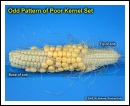 Poor
kernel set, meaning unacceptably low kernel numbers, is a bad omen for fields
that otherwise appear to be in good shape. Good or poor kernel set is determined
from pollination through the early stages of kernel development; typically 2
to 3 weeks post-pollination.
Poor
kernel set, meaning unacceptably low kernel numbers, is a bad omen for fields
that otherwise appear to be in good shape. Good or poor kernel set is determined
from pollination through the early stages of kernel development; typically 2
to 3 weeks post-pollination.
Problems with kernel set stem from ineffective pollination, kernel abortion, or both. Distinguishing between these two symptoms is easy. Determining the exact cause of the problem is often difficult.
The potential loss in grain yield caused by lower kernel numbers per ear can be estimated using the formula of the so-called Yield Component Method first described by the Univ. of Illinois many years ago (Univ. of Illinois, 2005). For example, the loss of only 1 kernel per row for a hybrid with 16-row ears and a stand count of 30,000 ears per acre would equal a potential yield loss of approximately 5 bushels per acre (1 [kernel] x 16 [rows] x 30 [thousand ears per acre] divided by 90 [thousand kernels per bushel]).
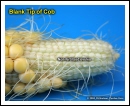 Poor
kernel set may be caused by ineffective pollination and the subsequent failure
to fertilize ovules on the cob. Ineffective pollination is characterized by
an absence of noticeable kernel development. In other words, all you see is
cob tissue. Pollination problems may be due to several stress factors this year,
sometimes working together to influence kernel set.
Poor
kernel set may be caused by ineffective pollination and the subsequent failure
to fertilize ovules on the cob. Ineffective pollination is characterized by
an absence of noticeable kernel development. In other words, all you see is
cob tissue. Pollination problems may be due to several stress factors this year,
sometimes working together to influence kernel set.
Severe drought stress, aggravated by excessive heat, can delay silk emergence to the extent that pollen shed is complete or nearly complete by the time the silks finally emerge from the husk. Without a pollen source, ovule fertilization cannot occur.
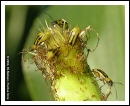 Persistent
severe silk clipping by insects such as the corn rootworm beetle or Japanese
beetle throughout the active pollen shed period can also limit the success of
pollination. The simultaneous effects of severe drought stress on silk emergence
can easily amplify the consequences of severe silk clipping.
Persistent
severe silk clipping by insects such as the corn rootworm beetle or Japanese
beetle throughout the active pollen shed period can also limit the success of
pollination. The simultaneous effects of severe drought stress on silk emergence
can easily amplify the consequences of severe silk clipping.
Severe drought stress coupled with excessive heat and low humidity can sometimes desiccate emerged silks to the point that they are no longer receptive to pollen grain germination. I suspect this is low on the list of possible stressors for Indiana most years (because of our typically high humidity levels), but may have played a role in some fields this year. Similarly, I doubt that pollen viability was an issue for Indiana cornfields because temperatures in the low 90's are usually not great enough to kill pollen.
Consecutive days of persistent rainfall or showers that keep tassels wet for many hours of a day can delay or interfere with anther exsertion and pollen shed. Remember the remnants of Hurricane Dennis that visited many parts of Indiana earlier last month? I admit to not having a lot of evidence to support the following conjecture, but I suspect that some of the simply weird patterns of poor kernel set evident in some fields that were trying to pollinate during that week may have been related to those many days of showery humid weather (coupled with the excessive cloudiness and its effect on photosynthesis).
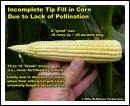 Exceptionally
long potential ears resulting from good weather during ear size determination
(not an issue for some Indiana fields this year) sometimes fail to pollinate
the final kernels near the tip of the cob. Remember, butt silks emerge first
and tip silks emerge last. With oversized ears, sometimes those tip silks emerge
after all the pollen has been shed. See the "Word to the Wise" below.
Exceptionally
long potential ears resulting from good weather during ear size determination
(not an issue for some Indiana fields this year) sometimes fail to pollinate
the final kernels near the tip of the cob. Remember, butt silks emerge first
and tip silks emerge last. With oversized ears, sometimes those tip silks emerge
after all the pollen has been shed. See the "Word to the Wise" below.
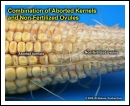 Poor
kernel set can also be a reflection of kernel abortion following successful
fertilization of the ovules on the cob. In contrast to ineffective pollination,
initial kernel development obviously precedes kernel abortion, so the symptoms
are usually shriveled remnants of kernels that may be whitish- or yellowish-translucent.
Poor
kernel set can also be a reflection of kernel abortion following successful
fertilization of the ovules on the cob. In contrast to ineffective pollination,
initial kernel development obviously precedes kernel abortion, so the symptoms
are usually shriveled remnants of kernels that may be whitish- or yellowish-translucent.
Kernel abortion results from severe stresses that greatly reduce the overall
photosynthetic output of the plant very early in the post-pollination grain-filling
period. 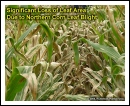 Obvious
photosynthetic stressors include severe drought & heat stress, consecutive days
of excessively cloudy weather and significant loss of photosynthetically active
leaf area (e.g., hail damage, leaf diseases, insect damage, nutrient deficiency).
Obvious
photosynthetic stressors include severe drought & heat stress, consecutive days
of excessively cloudy weather and significant loss of photosynthetically active
leaf area (e.g., hail damage, leaf diseases, insect damage, nutrient deficiency).
Warm nights during pollination and early grain fill may indirectly affect survival of developing kernels. Research suggests that the increased rate of kernel development due to warmer temperatures lowers the available amount of photosynthate per unit of thermal time; which then becomes a stressor to kernel development particularly at the tip of the ear, leading to kernel abortion (Cantarero et al., 1999).
A plethora (meaning a whole lot) of blank cob tips can quickly ruin the joy of walking a cornfield in the middle of August. Before getting too bent out of shape over the missing kernels, remember to count the number of harvestable kernels on those ears. I've been amazed at the number of fields I've walked the past week whose ears exhibit 1 to 2 inches of blank tips, yet still contain 16 rows by 30 to 35 harvestable kernels per row. Those are perfectly acceptable ear sizes in a year where dry weather has been a concern.
Cantarero, M.G., A.G. Cirilo, and F.H. Andrade. 1999. Night temperature at silking affects kernel set in maize. Crop Sci 39:703-710.
Nielsen, R.L. (Bob). 2004a. Estimating Corn Grain Yield Prior to Harvest. Corny News Network, Purdue Univ. Online at http://www.kingcorn.org/news/articles.04/YieldEst-0718.html [URL verified 8/8/05].
Nielsen, R.L. (Bob). 2004b. Grain Fill Stages in Corn. Corny News Network, Purdue Univ. Online at http://www.kingcorn.org/news/articles.04/GrainFill-0705.html [URL verified 8/8/05].
Nielsen, R.L. (Bob). 2004c. Yield Loss Potential During Grain Fill. Corny News Network, Purdue Univ. Online at http://www.kingcorn.org/news/articles.04/GrainFillStress-0705.html [URL verified 8/8/05].
Nielsen, R.L. (Bob). 2005b. Silk Emergence. Corny News Network, Purdue Univ. Available online at http://www.kingcorn.org/news/articles.05/Silks-0704.html [URL verified 7/4/05].
Nielsen, R.L. (Bob). 2005c. Tassel Emergence & Pollen Shed. Corny News Network, Purdue Univ. Available online at http://www.kingcorn.org/news/articles.05/Tassels-0704.html [URL verified 7/4/05].
Univ. of Illinois. 2005. Estimating Corn Yields. (An Online Calculator). Illinois Agronomy Handbook. Online at http://www.ag.uiuc.edu/iah/index.php?ch=ch2/est_corn_yield.html [URL verified 8/8/05].